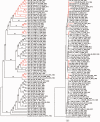Patterns and processes of Mycobacterium bovis evolution revealed by phylogenomic analyses
- PMID: 28201585
- PMCID: PMC5381553
- DOI: 10.1093/gbe/evx022
Patterns and processes of Mycobacterium bovis evolution revealed by phylogenomic analyses
Abstract
Mycobacterium bovis is an important animal pathogen worldwide that parasitizes wild and domesticated vertebrate livestock as well as humans. A comparison of the five M. bovis complete genomes from the United Kingdom, South Korea, Brazil, and the United States revealed four novel large-scale structural variations of at least 2,000 bp. A comparative phylogenomic study including 2,483 core genes of 38 taxa from eight countries showed conflicting phylogenetic signal among sites. By minimizing this effect, we obtained a tree that better agrees with sampling locality. Results supported a relatively basal position of African strains (all isolated from Homo sapiens), confirming that Africa was an important region for early diversification and that humans were one of the earliest hosts. Selection analyses revealed that functional categories such as “Lipid transport and metabolism,” “Cell cycle control, cell division, chromosome partitioning” and “Cell motility” were significant for the evolution of the group, besides other categories previously described, showing importance of genes associated with virulence and cholesterol metabolism in the evolution of M. bovis. PE/PPE genes, many of which are known to be associated with virulence, were major targets for large-scale polymorphisms, homologous recombination, and positive selection, evincing for the first time a plethora of evolutionary forces possibly contributing to differential adaptability in M. bovis. By assuming different priors, US strains originated and started to diversify around 150–5,210 ya. By further analyzing the largest set of US genomes to date (76 in total), obtained from 14 host species, we detected that hosts were not clustered in clades (except for a few cases), with some faster-evolving strains being detected, suggesting fast and ongoing reinfections across host species, and therefore, the possibility of new bovine tuberculosis outbreaks.
Figures




Similar articles
-
Global Distribution and Evolution of Mycobacterium bovis Lineages.Front Microbiol. 2020 May 7;11:843. doi: 10.3389/fmicb.2020.00843. eCollection 2020. Front Microbiol. 2020. PMID: 32477295 Free PMC article.
-
DNA restriction endonuclease analysis of Mycobacterium bovis and other members of the tuberculosis complex.J Clin Microbiol. 1985 Apr;21(4):562-4. doi: 10.1128/jcm.21.4.562-564.1985. J Clin Microbiol. 1985. PMID: 2985647 Free PMC article.
-
Phylogenomic Perspective on a Unique Mycobacterium bovis Clade Dominating Bovine Tuberculosis Infections among Cattle and Buffalos in Northern Brazil.Sci Rep. 2020 Feb 4;10(1):1747. doi: 10.1038/s41598-020-58398-5. Sci Rep. 2020. PMID: 32019968 Free PMC article.
-
Recent advances in our knowledge of Mycobacterium bovis: a feeling for the organism.Vet Microbiol. 2006 Feb 25;112(2-4):127-39. doi: 10.1016/j.vetmic.2005.11.050. Epub 2005 Dec 27. Vet Microbiol. 2006. PMID: 16384663 Review.
-
Mycobacterium bovis and Other Uncommon Members of the Mycobacterium tuberculosis Complex.Microbiol Spectr. 2016 Dec;4(6). doi: 10.1128/microbiolspec.TNMI7-0021-2016. Microbiol Spectr. 2016. PMID: 28084202 Review.
Cited by
-
Evolution and emergence of Mycobacterium tuberculosis.FEMS Microbiol Rev. 2024 Mar 1;48(2):fuae006. doi: 10.1093/femsre/fuae006. FEMS Microbiol Rev. 2024. PMID: 38365982 Free PMC article. Review.
-
Detection of a streptomycin-resistant Mycobacterium bovis strain through antitubercular drug susceptibility testing of Tunisian Mycobacterium tuberculosis complex isolates from cattle.BMC Vet Res. 2018 Sep 29;14(1):296. doi: 10.1186/s12917-018-1623-9. BMC Vet Res. 2018. PMID: 30268120 Free PMC article.
-
Global Distribution and Evolution of Mycobacterium bovis Lineages.Front Microbiol. 2020 May 7;11:843. doi: 10.3389/fmicb.2020.00843. eCollection 2020. Front Microbiol. 2020. PMID: 32477295 Free PMC article.
-
Genetic Diversity and Potential Paths of Transmission of Mycobacterium bovis in the Amazon: The Discovery of M. bovis Lineage Lb1 Circulating in South America.Front Vet Sci. 2021 Feb 16;8:630989. doi: 10.3389/fvets.2021.630989. eCollection 2021. Front Vet Sci. 2021. PMID: 33665220 Free PMC article.
-
A case report of transmission and disease caused by Mycobacterium caprae and Mycobacterium bovis in Lima, Peru.BMC Infect Dis. 2021 Dec 20;21(1):1265. doi: 10.1186/s12879-021-06944-5. BMC Infect Dis. 2021. PMID: 34930187 Free PMC article.
References
-
- Abdallah A, et al. 2006. A specific secretion system mediates PPE41 transport in pathogenic mycobacteria. Mol Microbiol. 62:667–679. - PubMed
-
- Akhter Y, Ehebauer MT, Mukhopadhyay S, Hasnain SE. 2012. The PE/PPE multigene family codes for virulence factors and is a possible source of mycobacterial antigenic variation: perhaps more? Biochimie. 94:110–116. - PubMed
-
- Allen AR, et al. 2013. The phylogeny and population structure of Mycobacterium bovis in the British Isles. Infect Genet Evol. 20:8–15. - PubMed
LinkOut - more resources
Full Text Sources
Other Literature Sources

